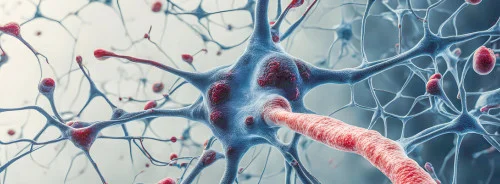Accurately diagnosing and predicting disease progression in Multiple Sclerosis (MS) are critical to providing timely and effective treatment. Key to this process are MRI and biofluid biomarkers, which offer invaluable insights into disease activity, progression, and response to immunotherapy. Recent studies have focused on the evolving role of these biomarkers in diagnosing MS and predicting its course, highlighting their growing importance in clinical decision-making. A recent comment published in The Lancet Regional Health Europe explores how MRI and biofluid biomarkers are shaping the future of MS management and the challenges that still need to be addressed.
MRI Biomarkers: Enhancing Diagnostic Accuracy
Magnetic resonance imaging (MRI) plays a central role in diagnosing MS, with the 2017 McDonald criteria underscoring its importance in disease identification. To avoid misdiagnosis, standardised brain and spinal cord MRI protocols should be applied across centres, and interpretation should be performed by experienced radiologists. Novel MRI biomarkers such as cortical lesions (CLs) and paramagnetic rim lesions (PRLs) enhance the precision of early diagnosis, providing insight into disease dissemination and progression. For example, the central vein sign (CVS) is emerging as a promising diagnostic tool, helping differentiate MS from other conditions by identifying characteristic venous patterns within lesions. While MRI technology continues to advance, functional and cognitive outcomes are still not adequately incorporated into current diagnostic criteria, representing an area for future improvement.
Beyond diagnosis, MRI biomarkers are instrumental in predicting disease outcomes. Conventional MRI measures, such as lesion count and location, provide critical indicators of disability progression, especially in progressive forms of MS. Spinal cord lesions, in particular, have been associated with more severe disease courses. However, distinguishing MS-specific neuroimaging features from those of other demyelinating disorders remains challenging, necessitating ongoing improvements in MRI technology. Advanced imaging techniques, including magnetisation transfer imaging and diffusion tensor imaging, offer additional insights into disease heterogeneity and evolution, promising more accurate assessments of disease activity and treatment response.
Biofluid Biomarkers: A Window into Disease Progression
Biofluid biomarkers, particularly those found in cerebrospinal fluid (CSF) and blood, are gaining recognition as valuable tools for diagnosing and monitoring disease progression in MS. Including CSF IgG oligoclonal bands in the 2017 McDonald criteria was a milestone in recognising the significance of biofluid biomarkers. Kappa-free light chains (κ-FLC) have emerged as a similar, easily accessible biomarker, providing a complementary method for diagnosing MS. Additionally, serum Neurofilament Light Chain (sNfL) has shown promise in predicting clinical relapses in relapsing-remitting MS (RRMS), offering a valuable tool for tracking disease activity over time.
Biofluid biomarkers also offer the potential to distinguish between different MS subtypes, reflecting the underlying pathophysiological mechanisms of the disease. Markers such as sNfL, GFAP (Glial Fibrillary Acidic Protein), and CHI3L1 have been associated with neuroaxonal damage, astroglial pathology, and microglial involvement, respectively. These markers provide a more detailed understanding of disease progression, helping classify MS activity subtypes. Moreover, advancements in neuroproteomics are leading to the identification of brain-derived proteins like CNTN2 and APLP1, which may indicate synaptic dysfunction in MS. With the development of highly sensitive assays, these proteins can be detected in blood samples, enabling easier and more accessible biomarker tracking.
The Future of MS Management: Combining Imaging and Biomarkers
The future of MS management lies in integrating multiple biomarker profiles and combining MRI and biofluid biomarkers to create a more comprehensive understanding of disease progression and treatment response. Multimodal approaches incorporating optical coherence tomography (OCT), positron emission tomography, or advanced MRI techniques, such as 7T MRI, offer the potential for more accurate identification of patients at high risk of disability progression. However, these advanced imaging modalities are not yet feasible for routine clinical use.
Artificial intelligence (AI) also holds great potential in this area, with the ability to automate lesion detection, quantify disease burden, and improve diagnostic accuracy. AI-driven data science approaches can help develop composite biomarker scores, enhancing the ability to predict disease outcomes and guide personalised treatment strategies. However, these emerging technologies must undergo rigorous validation and standardisation before fully incorporating them into clinical practice.
Conclusion
MRI and biofluid biomarkers revolutionise how MS is diagnosed and managed, providing critical insights into disease activity, progression, and treatment response. While significant advancements have been made, challenges remain, including the need for more reliable biomarkers to monitor disease progression and differentiate between MS subtypes. The future of MS management will likely involve multimodal biomarker profiles and AI-driven technologies, offering the potential for more accurate diagnosis, prognostication, and personalised treatment strategies. By addressing these challenges and continuing to refine the use of MRI and biofluid biomarkers, clinicians can improve patient outcomes and enhance the overall management of this complex disease.
Source: The Lancet Regional Health Europe
Image Credit: iStock
References:
Anderhalten L, Wohlrab F, Paul F (2024) Emerging MRI and biofluid biomarkers in the diagnosis and prognosis of multiple sclerosis. The Lancet Regional Health Europe.






